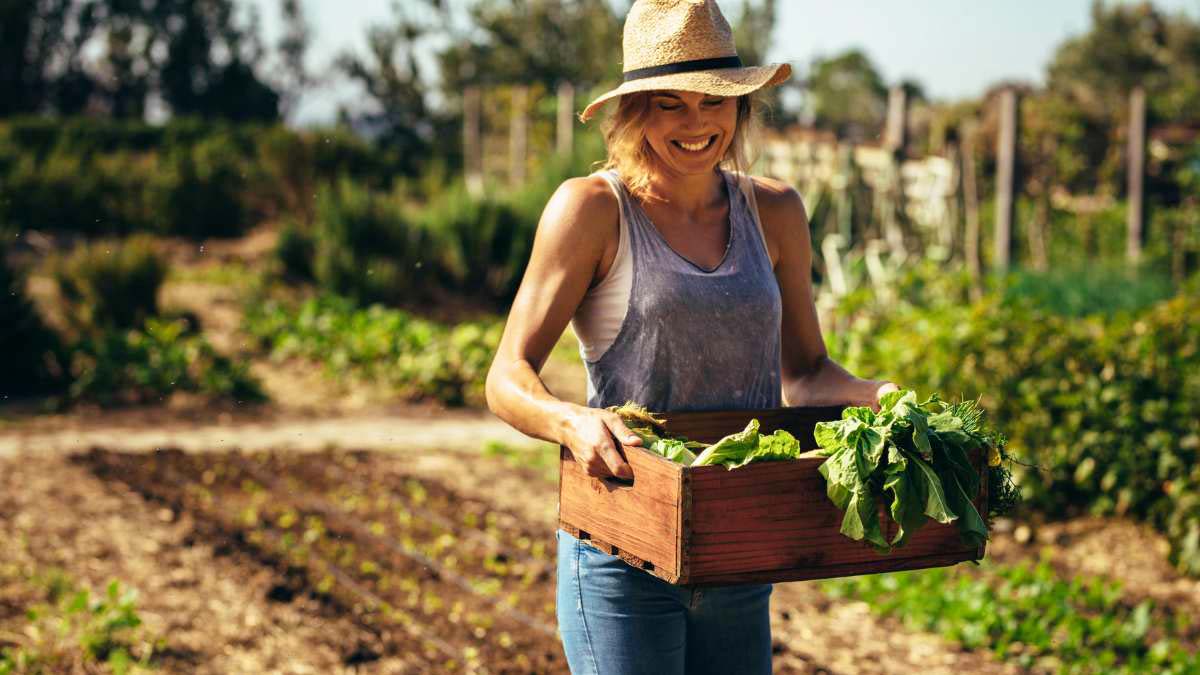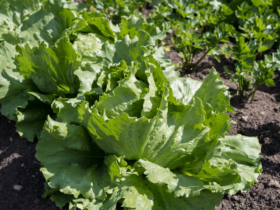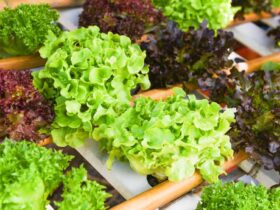A front yard vegetable garden is a productive and sustainable way to utilize your outdoor space. In recent years, there has been a growing trend towards growing edible plants in the front yard, combining beauty with functionality.
By incorporating fruits, vegetables, and herbs into your front yard landscaping, you not only create a visually appealing space but also have easy access to fresh, homegrown produce. This can be especially beneficial for those who want to embrace a more self-sufficient and sustainable lifestyle.
We will explore the benefits of a front yard vegetable garden, discuss design considerations, and provide tips for successful cultivation. So, let’s dive in and discover the joys of growing your own food in your front yard.
Choosing The Right Plants
When it comes to front yard vegetable gardens, selecting the right plants is crucial for a successful and productive harvest. Not all vegetables are suited for front yard gardens, therefore it’s important to choose plants that will thrive in this unique environment.
Vegetables That Thrive In A Front Yard Garden
If you’re considering starting a front yard vegetable garden, it’s essential to select vegetables that are well-suited for this type of setting. Some vegetables have specific requirements that make them ideal for front yard gardens:
- Leafy greens: Vegetables like lettuce, spinach, and kale are excellent choices for a front yard garden. They are relatively low-growing and can tolerate partial shade, making them perfect for areas with limited sunlight.
- Root crops: Carrots, radishes, and beets are vegetables that thrive in well-drained soil, making them a great option for front yard gardens. These crops also have shallow roots, which makes them ideal for small spaces.
- Herbs: Many herbs, such as basil, rosemary, and thyme, can be grown successfully in front yard gardens. They not only add flavor to your meals but also provide aesthetic appeal with their fragrant foliage.
- Compact vegetables: Compact varieties of tomatoes, peppers, and cucumbers are excellent choices for front yard gardens. These plants are specifically bred to grow in limited spaces, ensuring you can enjoy fresh produce without sacrificing your front yard’s aesthetic.
Considerations For Selecting Plants
When selecting plants for your front yard vegetable garden, keep these considerations in mind:
- Climate: Choose vegetables that are well-suited for your climate. Some varieties thrive in cooler temperatures, while others prefer warmth. Research the specific requirements of each plant to ensure it will grow successfully in your area.
- Growing conditions: Take into account the amount of sunlight and shade your front yard receives throughout the day. Not all vegetables require full sun, and some may even prefer partial shade. Ensure your plant choices align with the available growing conditions.
- Soil quality: Assess the quality of your front yard soil. Conduct a soil test to determine its pH levels, texture, and nutrient content. Some vegetables have specific soil requirements and may perform best in loamy or well-drained soil.
- Space availability: Consider the size of your front yard and the available space for your vegetable garden. Opt for compact varieties that won’t overshadow or overcrowd other plants. Utilize vertical gardening techniques to maximize your space efficiently.
By carefully selecting the right plants for your front yard vegetable garden, you can create a thriving and visually appealing space that yields a bountiful harvest.
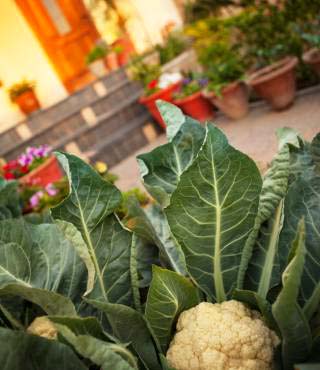
Preparing The Soil
When it comes to setting up a front yard vegetable garden, one of the most crucial steps is preparing the soil. A well-prepared soil provides the necessary nutrients for your plants to grow and thrive. In this section, we will discuss two important aspects of preparing the soil: testing the soil for nutrients and achieving the optimal soil composition.
Testing The Soil For Nutrients
Before you start planting, it is essential to test the soil in your front yard vegetable garden. Testing the soil helps you understand what nutrients are present and what may be lacking. To test the soil, follow these simple steps:
- Begin by collecting soil samples from different areas of your garden.
- Make sure to take samples from both the surface and deeper layers of soil.
- Put the soil samples in separate containers and label them accordingly.
- Take your soil samples to a reputable soil testing lab or use a home soil testing kit.
- The soil test results will provide valuable information about the pH level and nutrient content of your soil.
By testing the soil, you can identify any deficiencies or imbalances and take appropriate measures to enhance the health of your plants.
Optimal Soil Composition For A Successful Garden
Achieving the optimal soil composition is key to a successful front yard vegetable garden. Here are some factors to consider:
- PH levels: Most vegetables prefer a slightly acidic to neutral soil pH range of 6.0 to 7.0.
- Organic matter: Adding organic matter such as compost or well-rotted manure helps improve soil structure and fertility.
- Texture: A desirable soil texture is loamy, which is a balanced mixture of sand, silt, and clay. Loamy soil holds moisture and nutrients well while allowing proper drainage.
- Drainage: Good drainage is important to prevent waterlogging, which can lead to root rot. The soil should retain enough moisture for the plants, but excess water should be able to drain away.
By optimizing these factors, you create a hospitable environment for your vegetable plants to grow and thrive. Remember to regularly monitor and adjust the soil composition as needed throughout the growing season.
Designing The Layout
Transform your front yard into a thriving vegetable garden by skillfully designing the layout for optimal space utilization and aesthetic appeal. Create a harmonious balance between functionality and beauty with strategic placement of raised beds, pathways, and trellises.
Maximizing Space Through Companion Planting
One effective way to maximize the space in your front yard vegetable garden is through companion planting. This technique involves growing different plants together that have mutually beneficial relationships. By strategically placing plants with complementary needs and characteristics, you can optimize the use of your available space while promoting healthy growth and preventing pests.
- Consider planting tall vegetables such as tomatoes next to climbing plants like beans or peas, allowing them to support each other and utilize vertical space efficiently.
- Pairing certain plants together can also help deter pests. For instance, planting marigolds alongside your vegetables can ward off harmful insects due to their natural pest-repellent properties.
- Herbs like basil and cilantro can attract pollinators like bees and butterflies, benefiting neighboring vegetable plants that require pollination for successful fruiting.
Creating Attractive And Functional Garden Beds
When designing your front yard vegetable garden, it’s important to prioritize both aesthetics and functionality. By creating attractive and functional garden beds, you can enhance the overall visual appeal of your space while ensuring easy access and maintenance.
- Start by selecting the shape and size of your garden beds to complement the existing layout of your front yard. Rectangular or curved beds can add visual interest and fit well within various design styles.
- Consider using raised beds, which not only provide a defined boundary for your vegetables but also offer better drainage and soil aeration. Raised beds can be built using various materials such as wood, stone, or brick, depending on your preferences.
- Organize your plants in a logical and practical manner, grouping those with similar watering and sunlight requirements together. This simplifies watering and maintenance tasks, optimizing the efficiency of your gardening efforts.
- Add mulch around your garden beds to help retain moisture, suppress weeds, and create a neater appearance. Organic materials like straw, wood chips, or compost work well as mulch options.
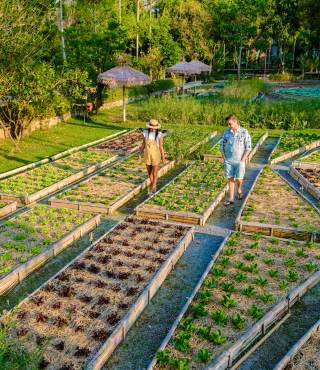
Managing Sunlight And Shade
Properly managing sunlight and shade is crucial for a successful front yard vegetable garden. Ensure your plants receive the right amount of light and shade to optimize growth and yield.
Managing sunlight and shade is crucial for the success of your front yard vegetable garden. Determining the ideal sun exposure for different vegetables and creating shade for sun-sensitive plants are important considerations. Understanding these aspects will help you optimize the growth and productivity of your garden.
Determining The Ideal Sun Exposure For Different Vegetables
Each vegetable has its own specific sunlight requirements to thrive and produce a bountiful harvest. Knowing these requirements can greatly enhance your gardening success. Here are some general guidelines to determine the ideal sun exposure for different vegetables:
- Root vegetables like carrots and radishes prefer full sun, which generally means at least six hours of direct sunlight per day. Providing them with adequate sunlight ensures proper root development and higher yields.
- Leafy greens such as lettuce, spinach, and kale can tolerate some shade. They usually perform well with three to four hours of direct sunlight and partial shade in the afternoon. This helps protect them from scorching in the hot summer months.
- Tomatoes, peppers, and cucumbers thrive in full sun. They require a minimum of six to eight hours of direct sunlight each day to produce abundant fruits. Placing them in a spot with ample sunlight will promote healthy growth and optimize their productivity.
- Herbs like basil, parsley, and thyme prefer full sun, similar to most fruiting vegetables. They need at least six hours of direct sunlight to develop their aromatic flavors and essential oils.
Understanding the specific sun requirements of each vegetable will enable you to plan the layout of your front yard vegetable garden effectively.
Creating Shade For Sun-sensitive Plants
While most vegetables thrive in direct sunlight, there are certain sun-sensitive plants that require some shade to prevent wilting or scorching. Creating shade for these plants is essential to protect them from the intense heat of the sun. Here are a few methods to provide shade for your sun-sensitive plants:
- Using shade cloth: Install a shade cloth over your plants to filter the sunlight and reduce its intensity. These cloths come in various levels of shade, allowing you to adjust the amount of sunlight reaching your plants.
- Utilizing natural shade: Take advantage of existing structures, such as trees or fences, to create natural shade for your plants. Position your sun-sensitive plants strategically so they receive shade during the hottest part of the day.
- Implementing companion planting: Pairing sun-sensitive plants with taller, sun-loving plants can provide them with the necessary shade. For instance, planting sunflowers near delicate lettuce can provide shade and prevent the lettuce from bolting in the summer heat.
Creating shade for sun-sensitive plants ensures they receive the right amount of sunlight without being overwhelmed by excessive heat. By taking these precautions, you can maintain a healthy and vibrant front yard vegetable garden that thrives in every corner. In conclusion, managing sunlight and shade in your front yard vegetable garden is essential to maximize productivity and protect sun-sensitive plants. Understanding the ideal sun exposure for different vegetables and implementing shade solutions will contribute to the overall success of your garden.
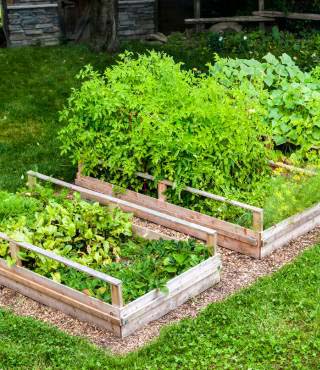
Watering And Irrigation
Ensuring proper watering and irrigation for your front yard vegetable garden is essential for healthy plant growth and abundant harvest. In this section, we will discuss establishing a watering schedule and choosing the right irrigation system that suits your garden’s needs.
Establishing A Watering Schedule
Establishing a regular watering schedule helps your plants receive consistent moisture, allowing them to thrive. Here are a few important factors to consider when setting up your watering routine:
- Plant needs: Different vegetables have varying water requirements. Research the water needs of each plant in your garden and group them accordingly.
- Soil type: Sandy or loamy soil retains water differently. Observe and adjust your watering frequency and duration based on your soil’s water-holding capacity.
- Climate: Hotter climates may require more frequent watering, especially during dry spells. Be mindful of weather patterns to anticipate watering needs.
By taking these factors into account, you can create a realistic watering schedule that prevents both under- and over-watering, promoting healthy plant growth.
Choosing The Right Irrigation System
Investing in an appropriate irrigation system can simplify and optimize your watering process. Consider the following options:
- Drip irrigation: This system delivers water directly to the plants’ root zones, minimizing evaporation and reducing the risk of diseases caused by wet foliage.
- Sprinklers: Ideal for larger gardens, sprinklers evenly distribute water over a wider area. Adjust the sprinkler heads to avoid water waste in non-vegetable areas.
- Soaker hoses: These porous hoses release water slowly along their length, allowing a gradual and deep watering of the garden beds.
Each irrigation system has its advantages, so choose the one that suits your garden size, layout, and water requirements. Remember to regularly check for leaks or clogs in your system and make necessary adjustments.

Pest And Disease Control
Introductory Paragraph
Growing a front yard vegetable garden comes with its own challenges, one of which is dealing with pests and diseases that can harm your plants. However, by implementing effective pest prevention methods and being able to identify common garden pests and diseases, you can ensure the health and productivity of your garden. In this section, we will explore natural methods for pest prevention and provide valuable insights on identifying and tackling common garden pests and diseases.
H3 Heading: Natural methods for pest prevention
Natural Methods For Pest Prevention
When it comes to keeping pests at bay in your front yard vegetable garden, natural methods can be highly effective. Not only do they help maintain a healthy ecosystem, but they also minimize the use of harmful chemicals. Here are a few natural methods for pest prevention in your vegetable garden:
Unordered List
- Encourage beneficial insects such as ladybugs and lacewings, which prey on garden pests like aphids and caterpillars.
- Plant companion plants that repel pests, for example, marigolds can deter nematodes.
- Use organic pest control sprays made from ingredients like neem oil, garlic, or chili pepper.
- Provide physical barriers like netting or row covers to protect your plants from larger pests like rabbits or birds.
- Maintain proper garden hygiene by removing debris and weeds regularly, as they can attract pests.
H3 Heading: Identifying common garden pests and diseases
Identifying Common Garden Pests And Diseases
Recognizing common garden pests and diseases is crucial for timely intervention and effective control. By identifying them early on, you can prevent extensive damage. Here are some of the most common garden pests and diseases to watch out for:
Table
| Pests | Diseases |
| Aphids | Leaf spot |
| Cabbage worms | Blights |
| Slugs and snails | Root rot |
| Tomato hornworms | Mildew |
| Squash bugs | Wilts |
Conclusion No need for conclusion as per the instructions
Harvesting And Maintenance
One of the most rewarding aspects of having a front yard vegetable garden is the ability to enjoy the fruits of your labor. Harvesting fresh vegetables straight from your own garden is not only convenient but also incredibly satisfying. Additionally, proper maintenance ensures that your plants remain healthy and continue to yield a bountiful harvest. In this section, we will guide you through the essentials of harvesting and maintaining your front yard vegetable garden.
Knowing When To Harvest Vegetables
Knowing when to harvest your vegetables is key to their optimal taste and nutrition. Below, we have compiled a list of indicators to help you determine when your vegetables are ready to be picked:
- Check for visible signs: Inspect your vegetables closely and look for visual cues that indicate maturity. This can include changes in color, size, or overall appearance that are specific to the plant variety.
- Feel the texture: Gently squeeze the vegetables to test their firmness. For example, ripe tomatoes should have a slight give when pressed.
- Read the plant labels: The labels provided with your seeds or plants often contain approximate harvest times. These can serve as a helpful guideline.
- Taste-test: If you are unsure about the readiness of a vegetable, you can always sample a small piece. This helps determine if it has reached the desired flavor and texture.
Pruning And Maintaining Plant Health
Pruning and maintaining the overall health of your plants is essential to maximize their productivity and prevent disease. Here are some vital practices to follow:
- Regularly remove dead or dying foliage: This ensures that the plant can direct its energy towards producing high-quality fruits and vegetables.
- Prune unruly growth: Over time, certain plants may become unruly and develop excessive branches or suckers. Pruning these can help maintain a more compact and manageable plant size.
- Water wisely: Proper watering is crucial for plant health. Ensure your plants receive adequate hydration while avoiding overwatering, which can lead to root rot and other problems.
- Fertilize as needed: Supplementing your soil with the appropriate nutrients helps promote robust growth and enhance overall plant health. Follow recommended fertilization guidelines specific to each vegetable.
- Monitor for pests and diseases: Regularly inspect your plants for signs of pests or diseases. Early detection allows for timely intervention and prevents potential damage.
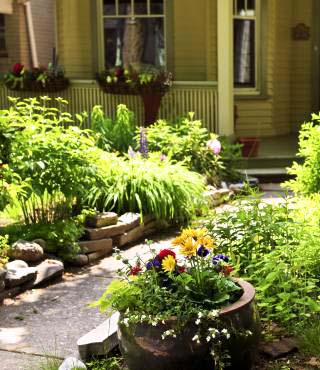
Community Engagement And Education
Discover the transformative power of front yard vegetable gardens for community engagement and education. Engage your neighbors in sustainable living while educating them about the benefits of growing their own food. Create a thriving community through shared knowledge and experiences.
Involving Neighbors And Community Members
Engaging neighbors and community members in your front yard vegetable garden can foster a sense of camaraderie and promote a healthier and more sustainable lifestyle. By involving others, you can create an inclusive and vibrant space that brings people together.
One way to involve neighbors is by organizing community gardening events, where everyone can come together to plant, tend, and harvest the vegetables. This not only provides an opportunity for people to connect with nature but also fosters a strong sense of community and shared responsibility for the garden.
Creating a shared garden space not only benefits the neighborhood in terms of providing fresh produce but also facilitates social interactions. People can exchange gardening tips, swap seeds and plants, and even share the fruits of their labor. Such interactions can help build strong relationships, spark conversations, and create lasting friendships among neighbors.
Sharing Gardening Knowledge And Experiences
A front yard vegetable garden can serve as an educational hub for gardening enthusiasts and beginners alike. Sharing knowledge and experiences is essential for fostering a community that is passionate about gardening and sustainability.
One way to share gardening knowledge is by hosting workshops or classes in your front yard garden. Whether it’s a beginner’s guide to vegetable gardening or a workshop on composting techniques, such events provide valuable insights and practical tips to community members.
Another way to share gardening knowledge is through online platforms and social media. Creating a community blog or Facebook group dedicated to your front yard garden can serve as a virtual space for exchanging ideas, asking questions, and sharing successes and challenges. This digital platform allows for continuous learning and connection, even beyond the confines of your neighborhood.
By creating an environment that promotes education and knowledge-sharing, your front yard vegetable garden can inspire others to start their own gardens, leading to a ripple effect of positive change in the community.
Frequently Asked Questions On Front Yard Vegetable Garden
Is It Ok To Grow Vegetables In Front Yard?
Yes, it is perfectly acceptable to grow vegetables in your front yard. Growing your own food can save money and promote a healthy lifestyle. Plus, it adds beauty and freshness to your home’s curb appeal.
What Vegetables Look Good In The Front Yard?
Some vegetables that look good in the front yard are colorful peppers, leafy lettuce, tall and sturdy tomatoes, vibrant Swiss chard and fragrant herbs like basil or thyme. These vegetables not only add visual appeal but also provide a fresh and tasty addition to your meals.
How Can I Make My Front Yard Vegetable Garden Attractive?
To make your front yard vegetable garden attractive: – Choose a variety of colorful and visually appealing vegetables. – Add decorative elements like trellises or raised beds. – Incorporate flowers and ornamental plants for a vibrant look. – Use creative planting patterns and arrangements.
– Maintain a neat and well-maintained garden space.
Can You Turn Your Front Yard Into A Garden?
Yes, you can transform your front yard into a garden. It’s a great way to make the most of your outdoor space and create a beautiful, green oasis. With proper planning and care, you can enjoy gardening and add value to your home.
Conclusion
A front yard vegetable garden can bring numerous benefits to your home and environment. Not only does it provide fresh and organic produce right at your doorstep, but it also promotes sustainable living and reduces food waste. Additionally, cultivating a vegetable garden in your front yard can enhance the aesthetic appeal of your home while promoting a sense of community and inspiring others to adopt similar practices.
Start your journey towards a greener and healthier lifestyle today!
